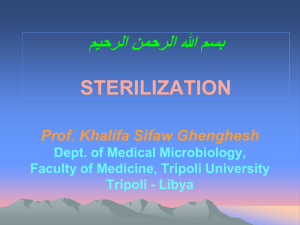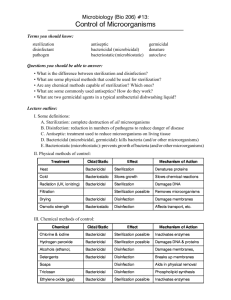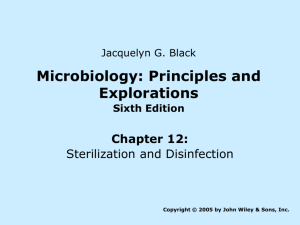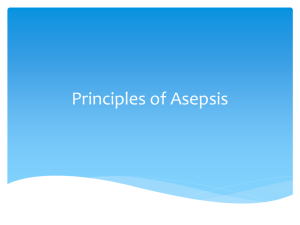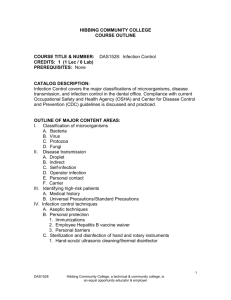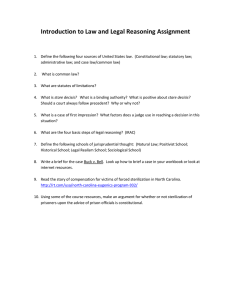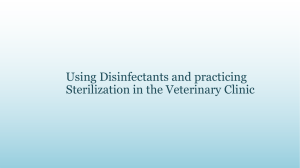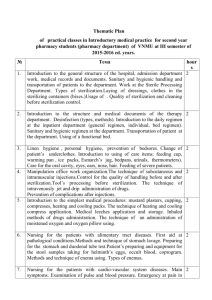update-sterilization2011-10
advertisement
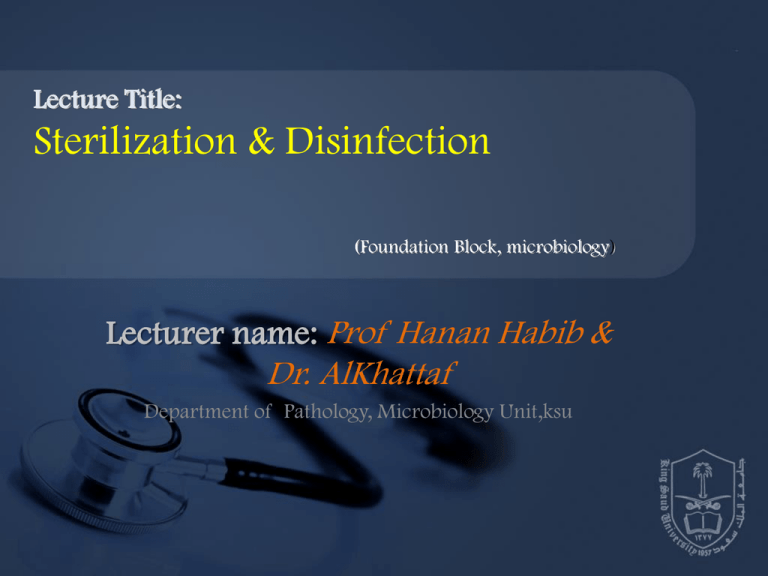
Lecture Title: Sterilization & Disinfection (Foundation Block, microbiology) Lecturer name: Prof Hanan Habib & Dr. AlKhattaf Department of Pathology, Microbiology Unit,ksu Lecture Objectives 1- Define the terms sterilization, disinfectant and antisepsis. 2- Classify the different methods of sterilization in physical and chemical method. 3- To recall the different physical methods of sterilization. 4- Know and realizes heat is the most important method of sterilization and that it should be used where ever that is possible. Lecture Objectives 5- Know the different types of heat sterilization methods. 6- Know dry heat as applied in hot air oven and moist heat as applied in autoclaves. 7- Know the principles of autoclave function and control method of sterilization process. 8- Know the importance of non heat sterilization methods and their use for sterilization of heat sensitive objects. Lecture Objectives 9-Know the difference between antiseptics and disinfectants. 10- Classify the disinfectants and antiseptics and know factors affecting their functions. 11- Know different applications for different disinfections and antiseptics. Definitions • Sterilization: complete killing of all forms of microorganisms, including bacterial spores • Disinfection: killing or removing of harmful vegetative microorganisms. • Disinfectant: chemical substance used to achieve disinfection. • Antiseptic: disinfectant that can be safely used on living tissues. Methods of sterilization A. Physical methods B. Chemical Methods PHYSICAL METHODS HEAT : Most important should be used when ever possible could be ; A-dry heat at temperature of 160˚C for one hour B- Moist heat eg .use of the Autoclave at121 or 134 C for 15 minute Radiation • U.V. light – Has limited sterilizing power because of poor penetration into most materials. Generally used in irritation of air in certain areas eg. Operating rooms and T.B. labs. • Ionizing radiation– e.g. Gamma radiation: Source Cobalt60 has greater energy than U.V. light, therefore more effective. Used mainly in industrial facilities e.g. sterilization of disposable plastic syringes, gloves, specimens containers and Petri dishes. Filtration • May be done under either negative or positive pressure. Best known example is the membrane filter made from cellulose acetate. Generally removes most bacteria but viruses and some small bacteria e.g. Chlamydias & Mycoplasmas may pass through. Thus filtration does not technically sterilize items but it adequate for circumstances under which is used. • Main use: for heat labile substances e.g. sera, antibiotics. Membrane filter Chemical Methods • Some chemical substances may be used to achieve sterilization e.g. Gluteraldehyde and Ethylene oxide. Sterilization by Heat Most common method Dry Heat • Dry Heat- kills microorganisms by destroying their oxidative processes. – Simplest method is exposing item to be sterilized to the naked flame e.g. Bunsen burner- for sterilizing bacteriological loops, knives, blades. – Hot air oven expose items to 160 °C for 1 hour. • Has electric element in chamber as source of heat plus a fan to circulate air for even distribution of heat in chamber. Oven without fan is dangerous. • Used for: metals ,Glassware, ointment/ oils/ waxes/powder ,i.e. items that are lacking water Hot air oven Moist Heat • • • • Uses hot water. Moist heat kills microorganisms by denaturating proteins. Autoclaving – standard sterilization method in hospitals. The equipment is called Autoclave and it works under the same principle as the pressure cooker where water boils at increased atmosphere pressure i.e. because of increase pressure the boiling point of water is >100 °C. The autoclave is a tough double walled chamber in which air is replaced by pure saturated steam under pressure. The Autoclave Advantages of Autoclave • 1. Temp. > 100 C therefore spores killed. • 2. Condensation of steam generates extra heat. • 3. The condensation also allows the steam to penetrate rapidly into porous materials. • Note: that autoclavable items must be steam permeable. Can not be used for items that are lacking water. • The air in the chamber is evacuated and filled with saturated steam. The chamber is closed tightly the steam keeps on filling into it and the pressure gradually increases. The items to be sterilized get completely surrounded by saturated steam (moist heat) which on contact with the surface of material to be sterilized condenses to release its latent heat of condensation which adds to already raised temperature of steam so that eventually all the microorganisms in what ever form –are killed. • The usual temperature achieved is 121 °C at a pressure of 15 pps.i. at exposure time of only 15 mins Monitoring of autoclaves • 1. Physical- use of thermocouple to measure accurately the temperature. • 2. Chemical- it consists of heat sensitive chemical that changes color at the right temperature and exposure time. • e.g. a)- Autoclave tape • b)- Browne’s tube. • 3. Biological – where a spore-bearing organism is added during the sterilization process and then cultured later to ensure that it has been killed. Moist heat: Other Applications Pasteurization • Used heat at temperatures sufficient to inactivate harmful organism in milk. The temperatures sterilization a not achieved . • Temperature may be 74°C, for 3-5 secs ( Flash method )or 62°C for 30 mins. (Conventional method ). • b)- Boiling – quite common especially in domestic circumstances. Pasteurization of milk • To prevent diseases like : Typhoid fever Brucellosis Tuberculosis Q fever Autoclave tape Browne’s tube Spore test II Sterilization by Chemical Methods Useful for heat sensitive materials e.g. plastics and lensed instruments endoscopes). 1. Ethylene Oxide Chamber Ethylene oxide alkylates DNA molescules and thereby inactivates microorganisms. Etylenes oxide may cause explosion if used pure so it is mixed with an inert gas e.g Neon, Feron at a ratio of 10:90 Requires high humidity and used at relative humidity 50-60% Temperature : 55-60°C and exposure period 4-6 hours. 2. Activated alkaline Gluteraldehyde 2% Immerse item in solution for about 20 mins. If organism is tuberculosis . But if spores then immersion period 2-3 hours. Factors influencing activity of disinfectants • 1. Activity directly proportional to temperature. • 2. Directly proportional to concentration up to a point – optimum concentration. After this level no advantage in further increases in concentration. Factors influencing activity of disinfectants (cont.) • 3. May be inactivated by – Dirt – Organic matter : Proteins, Pus, Blood, Mucus and Faeces. – Non organic: Cork,, Hard water and Some plastics. • 4. Time : Disinfectants need time to work. • 5. Range of Action : Disinfectants not equally effective against the whole spectrum of microbes. E.g. Chlorhexidine less active against GNB than Gram Positive cocci. Hypochlorites and Gluteraldehyde are more active against hepatitis viruses than most other disinfectants. Chemical disinfectants Activity against Disinfectant GPC Inactivated by Protein Soap Corrosive Action TB GNB Spores Phenolics Sudol ++ ++ _ + + _ + Izal ++ ++ _ _ + _ _ Soluble Phenolic* e.g. clearsol ++ ++ _ + + _ + to + Chlorine compound ++ ++ ++ + ++ _ (buffered ++ or + Solution) Lodophor ++ ++ + (Slow) + + _ _ Chorhexidine (Hibitane) ++ + _ _ _ _ _ 70° alcohol ++ ++ _ + ++ _ _ Formaldehyde ++ ++ ++ (slow) ++ + _ ++ Glutaraldehyde (Cidex) ++ ++ ++ + _ + ++ Hospital disinfection methods • • • • • • • • • • • Article Floors,walls Surfaces tables skin: Surgeons’hands Patient skin Endoscopes Thermometers Disinfectant phenolics fluids 1-2% hypochloride,alcohol chlorhexidine, iodine alcohol 70%alcohol,iodine gluteraldehyde2% (cidex),sub-atmospheric steam 70% Alcohol Reference book and the relevant page numbers.. • Sherris 175-185
